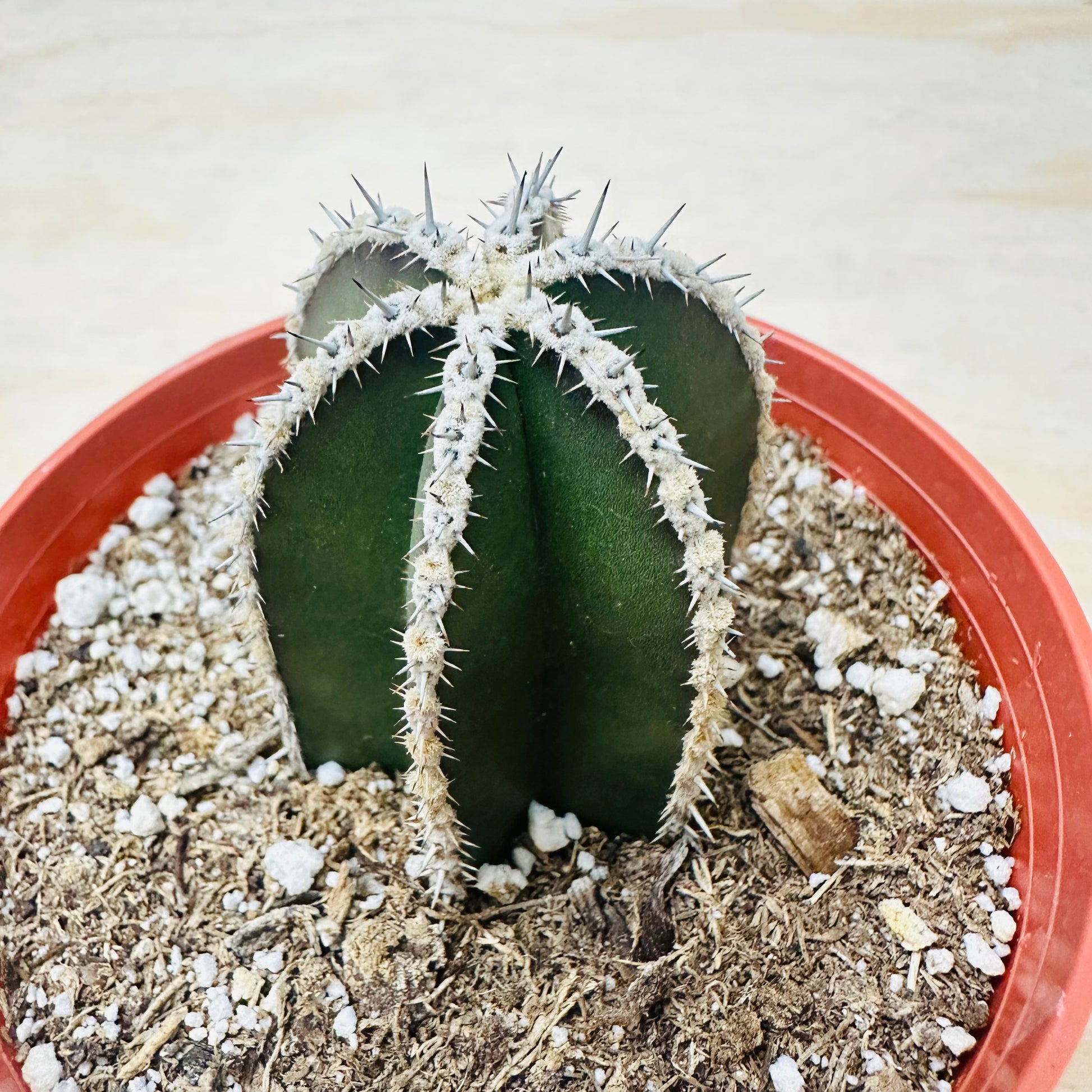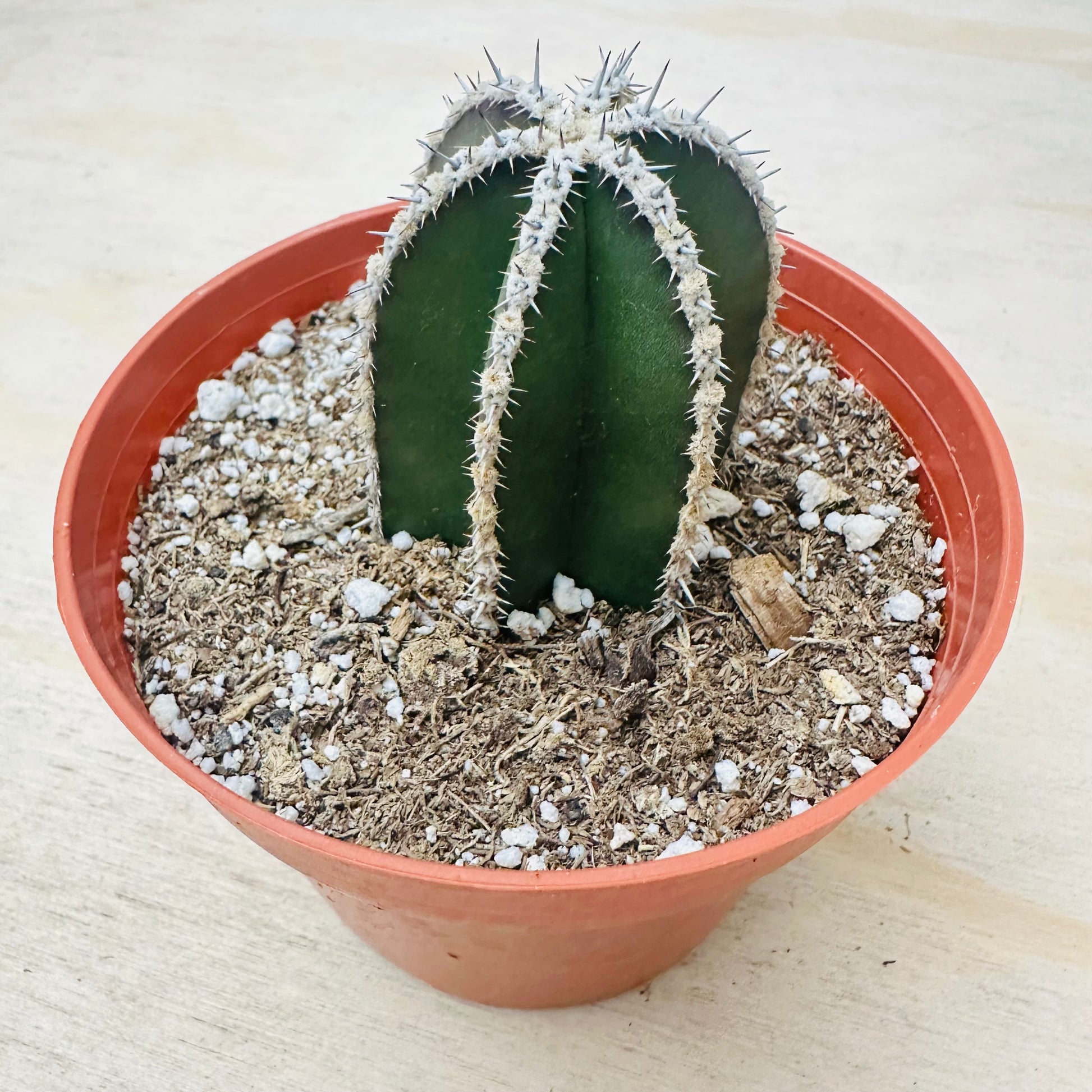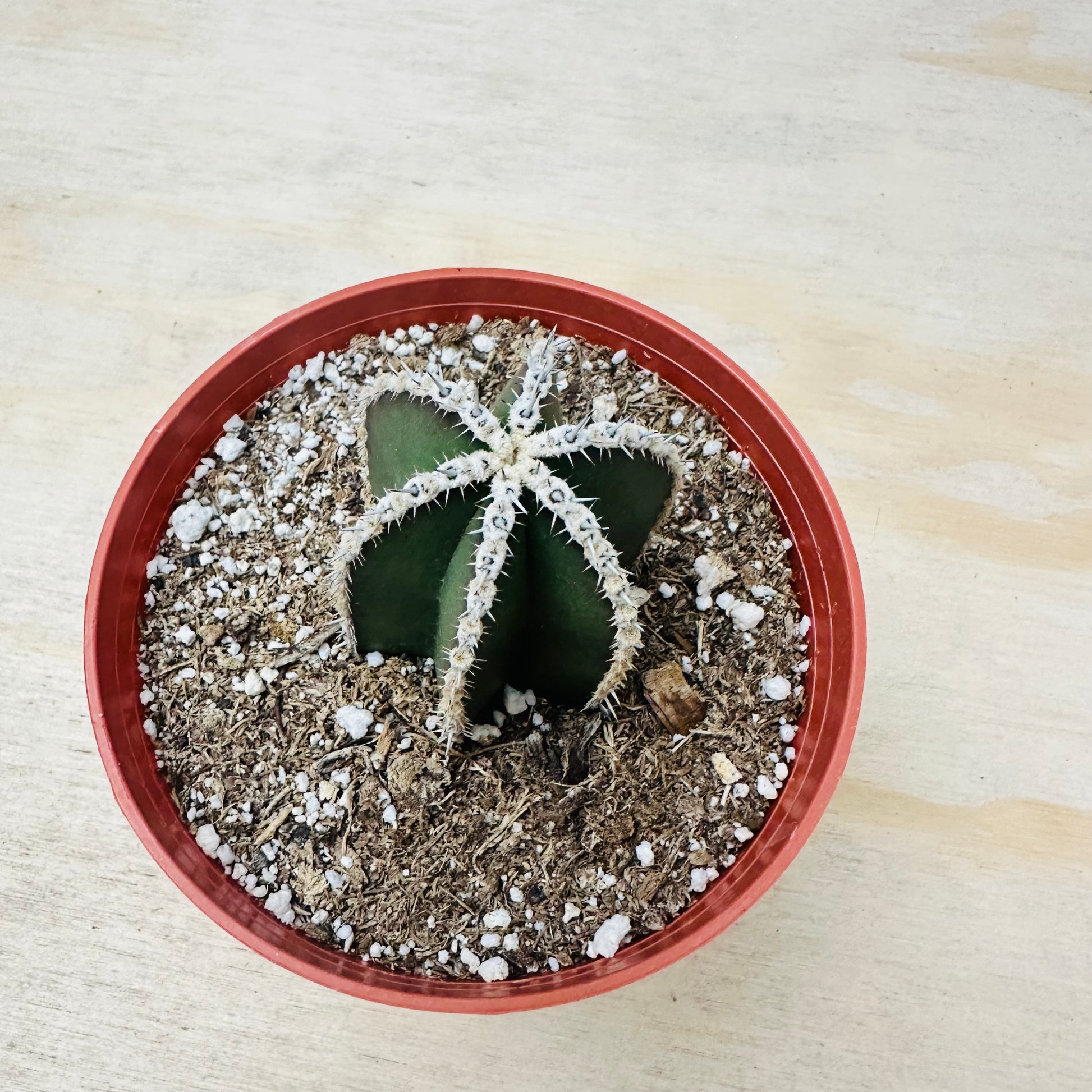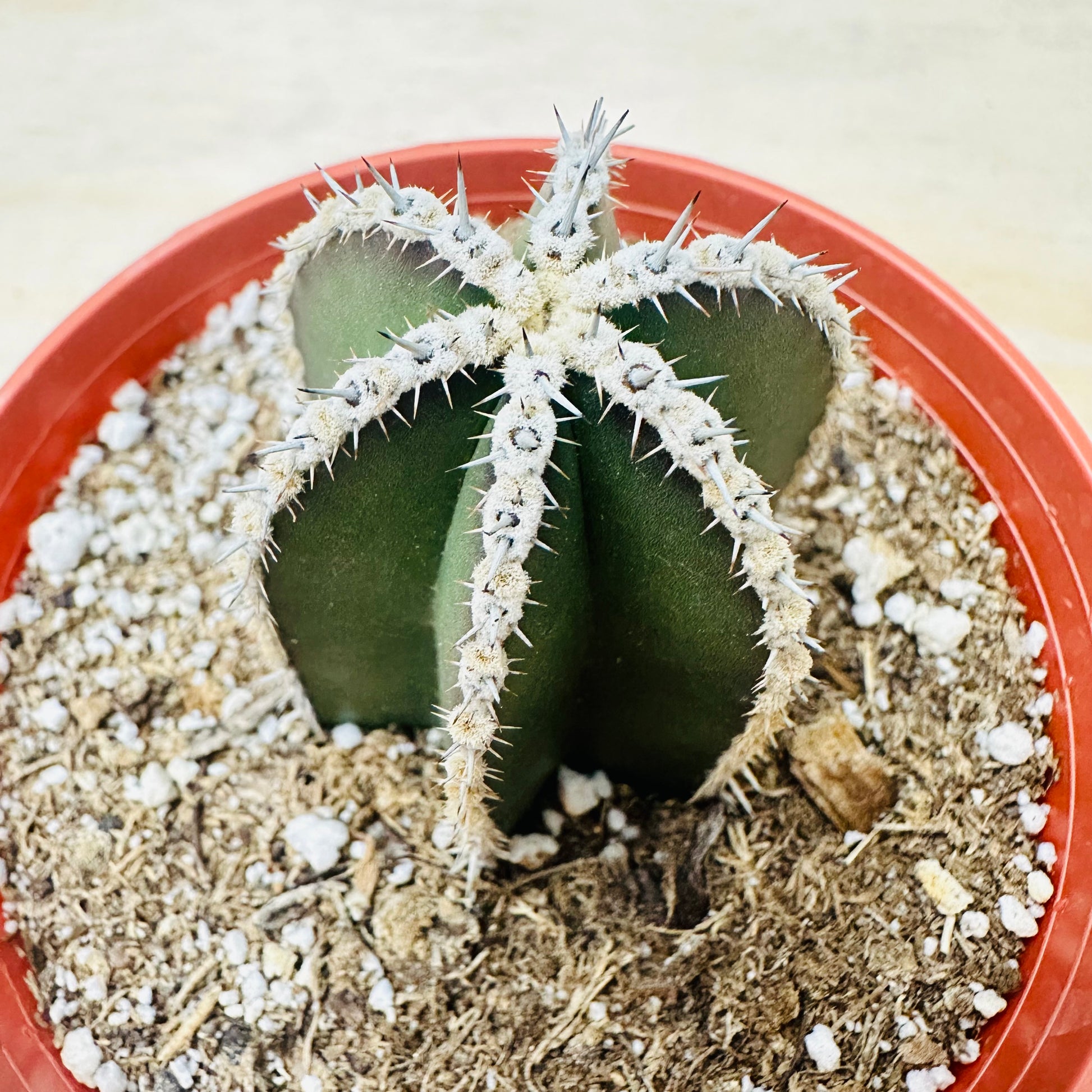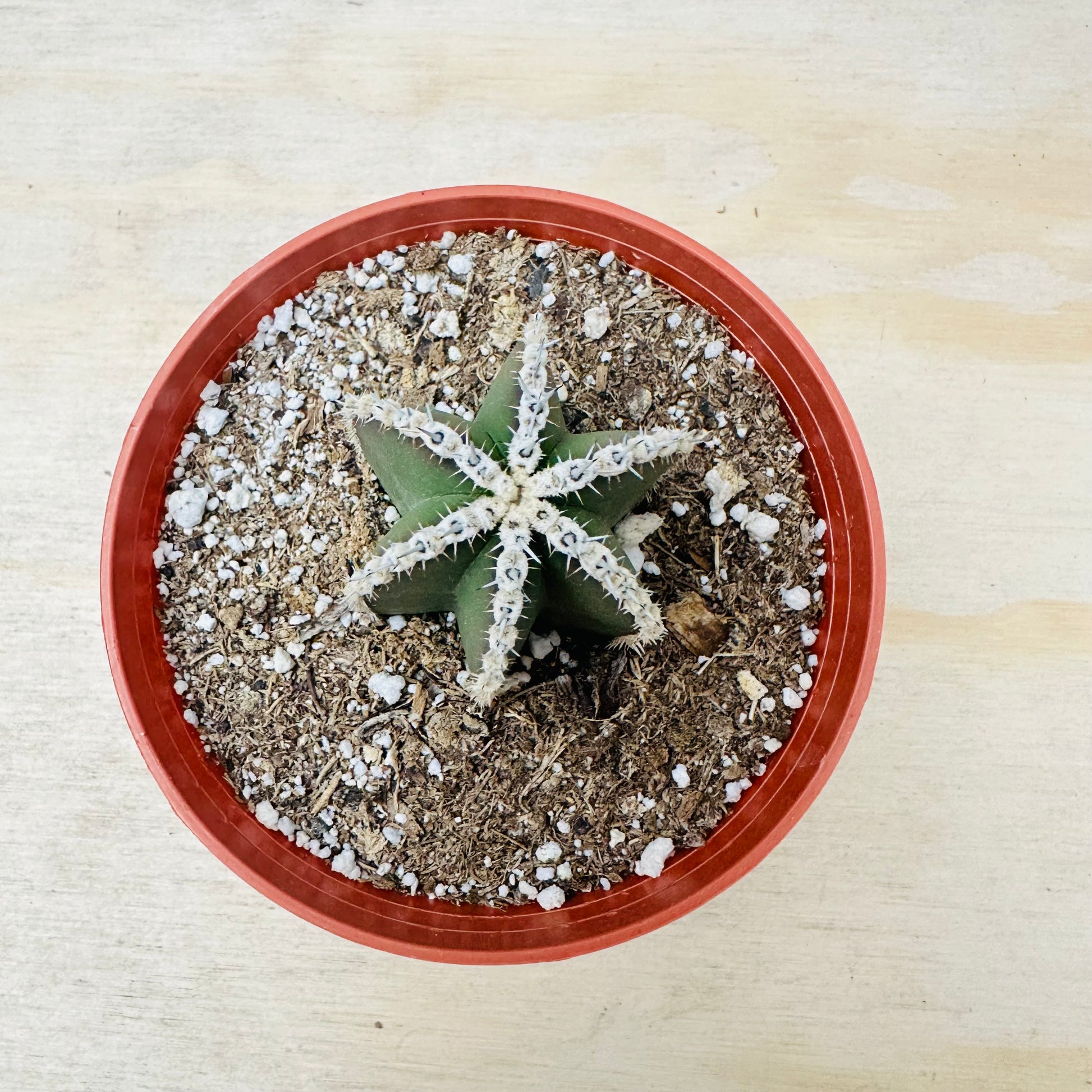Pachycereus marginatus - Mexican Fence Post Cactus
Pachycereus marginatus - Mexican Fence Post Cactus
In stock
Couldn't load pickup availability
📝 Description
**Morphological Characteristics**
Pachycereus marginatus, commonly known as the "Mexican Fence Post Cactus," is a tall, columnar cactus belonging to the Cactaceae family. Native to central Mexico, this species is widely admired for its stately, upright form and clean architectural lines, making it a popular choice for landscapes and large container plantings.
The stems are thick, cylindrical, and can grow up to 3-6 meters (10-20 feet) tall in their natural habitat, though in cultivation they typically reach about 1.5-3 meters (5-10 feet). Each stem is about 10-15 cm (4-6 inches) in diameter and features 5-7 prominent ribs. The surface is bright to blue-green, and along the ribs, evenly spaced areoles produce short, stout spines that are usually white to yellowish in color. In mature plants, small pinkish-white flowers may appear along the ribs, followed by red, fleshy fruits.
**Growth Habits**
Mexican Fence Post Cactus grows upright in a slow but steady manner, often forming multi-stemmed clusters over time. As the name suggests, it has historically been used in Mexico as a living fence due to its dense, impenetrable growth. In cultivation, it is commonly used as a striking vertical element in xeriscaping, desert gardens, and modern landscape designs.
**Maintenance Points**
• Lighting: Prefers full sun exposure. Outdoors, it should be planted in a bright, open area. Indoors, place it near a very bright window or under strong grow lights.
• Watering: Water deeply but infrequently during the growing season (spring and summer), allowing the soil to dry out completely between waterings. In winter, watering should be minimal to prevent rot.
• Soil: Requires a well-draining cactus or succulent soil mix. Amending with coarse sand, gravel, or pumice is essential to ensure proper drainage.
• Temperature: Thrives in temperatures between 21-32°C (70-90°F). It can tolerate short periods of light frost down to about -4°C (25°F) if kept dry but should be protected from prolonged freezing temperatures.
• Fertilization: Feed once a month during the growing season with a diluted, low-nitrogen fertilizer formulated for cacti. Do not fertilize during dormancy.
• Potting: When grown in containers, use deep pots with excellent drainage. Repot every 3-4 years or when the plant outgrows its container.
• Humidity: Prefers dry conditions. High humidity can increase the risk of fungal infections.
**Reproduction Method**
Pachycereus marginatus can be propagated through cuttings and seeds.
1. **Cuttings:**
• Selection: Cut a healthy stem segment with a clean, sharp knife.
• Callusing: Allow the cutting to dry and callus over for several weeks in a shaded, dry area.
• Planting: Plant the callused cutting into a well-draining cactus mix. Water sparingly until roots establish.
2. **Seeds:**
• Sowing: Sow seeds on the surface of a sterile, well-draining seed mix.
• Germination: Keep soil lightly moist and maintain temperatures between 24-30°C (75-86°F). Germination may take several weeks.
• Transplanting: Once seedlings are large enough to handle, move them into individual pots.
**Additional Tips**
• Safety Note: The spines, although not extremely long, can still cause injury. Handle with care and use gloves when planting or repotting.
• Pest Control: Watch for pests like scale insects and mealybugs. Treat infestations promptly with insecticidal soap or neem oil.
• Disease Prevention: Ensure excellent drainage and avoid overwatering to prevent root rot.
• Landscaping Use: Due to its strong vertical growth and clean form, it is ideal as a natural fence, privacy screen, or dramatic architectural accent.
With its stately appearance, resilience, and minimal maintenance needs, Pachycereus marginatus - Mexican Fence Post Cactus is a standout choice for creating structure and bold impact in cactus gardens, modern landscapes, and large containers.
🌿 Care Tips
Plant Care
Light
Water
Soil
Temperature
🌟 Note: It’s normal for succulents to appear slightly shriveled after shipping. They usually recover within a few days in a suitable environment.
📦 Shipping Info
Seah Shipping Policy
Effective Date: November 2025
This Shipping Policy applies to orders delivered within the continental United States (the lower 48 states). By purchasing from Seah, you agree to the terms below.
1) Shipping Cost & Free Shipping
- Automatic rate calculation: Shipping is calculated at checkout based on weight, destination ZIP and carrier rates.
- Free Standard Shipping: Orders $59+ (pre-tax, after discounts) ship free to the lower 48 states.
- Alaska, Hawaii, Puerto Rico & other territories: Not eligible for free shipping or standard flat offers at this time.
- Taxes/Duties: Applicable sales tax and any fees are shown at checkout.
2) Processing Schedule
- Business days only: We process and ship Monday–Friday. No shipping on weekends or U.S. federal holidays.
- Handling time: 1–3 business days after payment confirmation.
- Cut-off time: Orders placed before 3:00 PM (PST) are prioritized for same-day processing; others roll to the next business day.
- Changes/Cancellations: Email support@seah.co within 12 hours of purchase; after that, the order may already be in processing.
3) Transit Times
| Method | Estimated Transit | Total ETA (Handling + Transit) |
|---|---|---|
| Standard | 5–8 business days | 6–11 business days |
| Express | 3–4 business days | 4–7 business days |
ETAs are estimates. Weather, holidays, carrier delays or high-volume periods may extend delivery times.
4) Seasonal Temperature & Plant Safety
- Winter (Nov–Mar): We strongly recommend adding a heat pack at checkout to protect plants from freezing. Orders shipped without a heat pack during cold conditions are not covered for cold damage.
- Summer heat: During extreme heat waves, we may hold shipments until temperatures normalize. We’ll notify you if there’s a hold.
- Packaging: Plants are carefully packed (bare-root or potted by type/size) to minimize transit stress.
5) Carriers & Tracking
- We ship via USPS / UPS / FedEx, selected automatically for best service to your address.
- When your order ships, you’ll receive a tracking email. Tracking typically activates within 24 hours.
- If you haven’t received tracking within 3 business days, contact us at support@seah.co or +1 (626)-999-1314.
6) Address Changes & Delivery Issues
- Before shipment: Request address changes within 12 hours of ordering.
- After shipment: We can’t modify the address once dispatched. Please contact the carrier for redirection options.
- PO Boxes: Supported for USPS only; UPS/FedEx require a street address.
- Seah isn’t responsible for delays or loss due to incorrect addresses provided at checkout.
7) Service Area
We currently ship to the continental U.S. (lower 48 states). Orders to AK/HI/PR and other territories are not eligible for free shipping and may be restricted.
8) Support
- Hours: Mon–Fri, 9:00 AM – 5:00 PM (PST)
- Phone: +1 (626)-999-1314
- Email: support@seah.co
- Address: 7870 Margaux Pl, Rancho Cucamonga, CA 91739, United States
Thank you for supporting our California nursery—each plant is hand-selected and packed with care. 🌱






